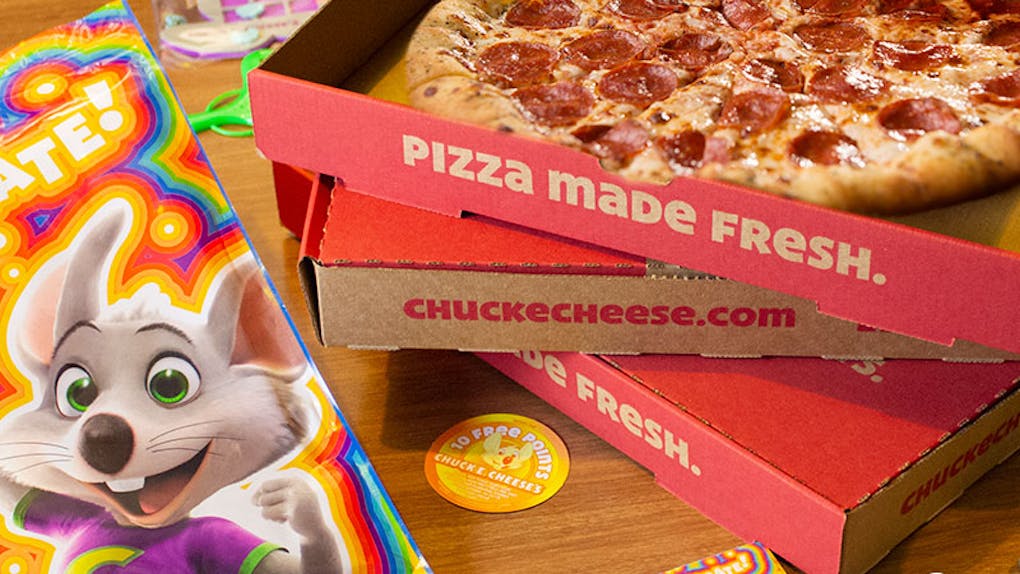
Popular internet personality Shane Dawson, 30, says he thinks it might be. Dawson added new fuel to a bizarre, decade-old conspiracy theory on Monday when he posted a YouTube video promising an in-depth investigation into misshapen pizzas.
Photos uploaded to Instagram, Yelp and TripAdvisor show the crusts on Chuck E. Cheese's slices don't always line up to form a perfect circle. To Dawson, who has more than 20 million subscribers on YouTube and whose videos have been viewed more than 4.7 billion times since 2005, this merited further research.
"So I noticed this when I was 8 years old or something," he said. "I was like, wait a minute, how come all the pieces are different?"
A Google search turned up two Yahoo! Answers threads from 10 years ago in which concerned customers postulated that staff at the family-friendly chain were recycling pizza slices that get left behind on the table after customers finish eating. In his video, Dawson strongly suggested that Chuck E. Cheese's employees could be reheating those leftover slices and using them to form new pizzas, though no evidence of this has emerged over the past decade.
"Just a theory," he said, later asking out loud, "Am I going to get sued?"
CEC Entertainment, the parent company for Chuck E. Cheese's, hasn't indicated yet whether it plans to take legal action against the YouTube star but responded Tuesday to the video, which had more than 14 million views as of early Wednesday morning.
"The claims made in this video about Chuck E. Cheese's and our pizza are unequivocally false," the chain said in a statement sent to multiple media outlets. "No conspiracies here - our pizzas are made to order and we prepare our dough fresh in restaurant, which means that they're not always perfectly uniform in shape, but always delicious."
In his video, Dawson attempted to investigate for himself by going to a Chuck E. Cheese's location in the greater Los Angeles area. While the footage shows he made no attempt to talk to employees or peer into the kitchen, he did order two pizzas, which both appeared to have a few unevenly sized slices.
"I mean, that's undeniable, that's crazy," Dawson said.
As the unfounded theory spread Tuesday around social media, setting off heated debates, past and present employees began offering their own rebuttals. In a video titled "Ex-Chuck E. Cheese Employee Responds To Shane Dawson's Conspiracy," a YouTuber going by the name Payden offered a logical explanation: The chain wants its pizzas to have the same number of slices each time, which can present a challenge for rushed kitchen workers. Sometimes, after pulling a pizza out of the oven, he said, he would start cutting it up only to realize that he had 10 slices instead of the 12 that he needed.
"You'll just find a really big piece of pizza and you'll only cut that one in half," he said. "Because of that, it'll start to make a line that doesn't end up anywhere and stuff like that. It'll make all of these lines look all funky."
Dawson joined YouTube in 2005 and became one of its biggest stars several years later when he began posting his comedy sketches, later facing backlash for his use of blackface and racial stereotypes. In 2014, the internet website Daily Dot reported that he had apologized and deleted most of the offensive videos.
His earlier output mostly featured made-to-go-viral stunts and jokes about pop culture. In the past year, he has posted gossipy documentaries about other prominent YouTubers and discussions with his friends about conspiracy theories. Dawson has posted disclaimers explaining that his conspiracy-focused videos are intended only as entertainment, not as statements of fact, the technology website the Verge has noted.
Monday's video, titled "Investigating Conspiracies with Shane Dawson," is categorized on the site as a comedy, even though it also features the story of a woman who claims to have narrowly escaped human trafficking in Serbia. So is a video posted last week in which Dawson suggests but doesn't outright state that deadly wildfires in California could have been caused by arson or exploding microwaves.
The rampant dissemination of conspiracy theories - often with much darker implications than a debate over pizza - has plagued YouTube for years. Last month, the company announced it was reworking the algorithm that suggests recommended videos so users will no longer be led down a rabbit hole of hoaxes and misinformation. The Washington Post reported Jan. 25 that the company has traditionally prioritized freedom of speech and has refrained from placing an outright ban on false stories.
Every weekday JewishWorldReview.com publishes what many in the media and Washington consider "must-reading". Sign up for the daily JWR update. It's free. Just click here.
(COMMENT, BELOW)


 Contact The Editor
Contact The Editor
 Articles By This Author
Articles By This Author